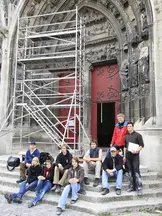Study historical and modern research objects first-hand

Bamberg is a UNESCO World Heritage Site. The buildings and museums in the city and its surroundings are first-class research objects and offer various opportunities for seminars, field trips and research work. In this setting, influenced by old and new art styles and a stone’s throw from Bamberg Cathedral and the Old Town Hall, you’ll also find the offices of both of the academic units in Art History.
Network studies
Both units for Art History are integrated into the Institute for Archaeology, Heritage Conservation Studies and Art History. With various subjects grouped together here, there are unique opportunities for interdisciplinary networking. Another distinctive feature of Bamberg’s Art History programme is the practice-oriented focus of its teaching and research.
Practical relevance
In addition to the professors of Art History and their assistants, students are also taught by Apl. Professor Dr. G. Ulrich Großmann, former managing director of the Germanisches Nationalmuseum in Nuremberg, Honorary Professor Dr. Gregor J. M. Weber, Head of the Department of Fine Arts at the Rijksmuseum in Amsterdam, Dr. Birgit Kastner (member of the administrative council, Department of Art and Culture of the Archdiocese of Bamberg) and Dr. Sebastian Karnatz (Bavarian Palace Administration). They regularly offer courses that take place either in Bamberg or in the museums and collection spaces they head. These are complemented by single-day or multi-day field trips and lectures given by invited specialists, where the focus is on practical training in the context of original pieces and establishing strong links to professional activity.
